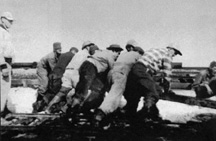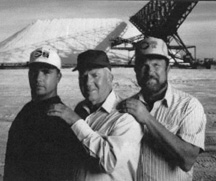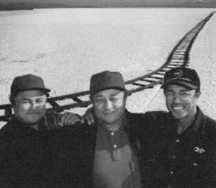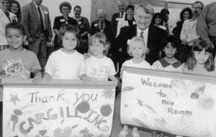THE BAY'S EDGE
Volume 8, Number 1, June 1997
SATL OF THE EARTH
The history of Northern California is a story of extra-ordinary natural resources and extraordinary people. The climate and topography of the Bay Area make It a good locale for solar salt production. But it is the extraordinary people who comprise the real history - and the heart - of the area’s salt industry.
| The people of the salt ponds have worked together for more than a century to create an industry and a South Bay community. |
 |
"People are our number-one asset," says Charles Sullivan, president of the Salt Division of Cargill, Incorporated and a former general manager of the company s San Francisco Bay salt operation. "We are fortunate to have a staff of dedicated employees who have deep roots in the Bay Area and, In many cases, decades or even generations of ties to the salt company. In today’s society, that dedication and longevity are rare and precious attributes."
Today, Cargill Salt employs 180 people full-time, and 75 sea-sonal workers, to harvest one million tons of salt from the Bay each year.
The first salt gatherers along the Bay shore were the Ohlone people, who collected salt that crystallized when waters receded.
The Spanish padres were next, driving wooden stakes into the marshes on which the precious salt crystallized. They used the salt to supply missions up and down the Coast. In 1854 sailor and adventurer John Johnson settled at Mount Eden and built the Bay Area’s first modem salt works to supply the booming West. Soon, a flood of other Northern European settlers laid out salt ponds and went into production. By 1868, there were 18 salt companies on the Bay most small and struggling. A long series of mergers from the turn of the century through the Great Depression - driven by economic pressures caused by increasing mechanization, growing sophistication in salt production and refining, and demand for salt of higher quality and purity - yielded a single salt company on the Bay: the Leslie Salt Co.
As the industry coalesced, new faces appeared in the salt ponds. The rolls at the salt company reflected the spectrum of Northern California’s population: Anglos, African-Americans, men and women of Japanese, Mexican, Central and South American, Italian, Portuguese, and Filipino descent — people from around the nation and around the world.
Through all the changes, one thing has remained constant: San Francisco Bay salt-making has been anchored In family ownership and family traditions. Leslie Salt was a closely held company of the spice-making Schilling family. When the Schillings sold Leslie in 1978, it was no coincidence that they chose to sell to Minneapolis-based Cargill, a large, family-owned company.
In many ways, families have always been the heart of the salt business. Cargill draws its employees from applicants through-out the community, including many sons and daughters who have followed the footsteps their parents left alongside the salt ponds.
Tom Enciso and his brother, Phil, Jr., started their careers with Leslie Salt as seasonal harvest crew workers in 1972. Their father, Phil Enciso, Sr., had taken the same path In 1951, supplementing the income from the family strawberry and hay farm in Newark before signing on full-time and moving up to shipping supervisor in the Newark warehouse until his retirement in 1993. Tom, now a waterman managing the flow of brines among the ponds, says, "the people I worked with were people I knew. Basically, they were the old fami-lies from the area. It was like working for family."
| Four generations of Newark's Cook family have worked in the shadow of the Bay's famous salt stacks. George Cook (center) follower his father, Jacob, into salt harvest work in 1940. George's son, Tim (right), eventually filled his father's shoes as foreman, and now works on the dredge Mallard II. Grandson Todd (left) works in the Newark rafinery. |
 |
Four generations of the Cook family have worked in the salt ponds, starting with Jacob Cook’s stints in 1939 and 1940 running a salt washer after harvesting hay and vegetables on his Newark ranch. His son, George, signed on as a seasonal worker during the 1940 harvest, moving temporary railroad tracks by hand. George farmed during World War II, then came back to seasonal salt work In 1946 with two brothers and his brother-in-law. In 1957. he went to work full-time for Leslie Salt Co., and worked his way up to Plant 2 foreman.
When George retired in 1983, his son, Tim. filled his shoes as foreman in Newark. Like his father, ‘fim started as a seasonal harvest worker. "When I was a little kid, I remember seeing what was going on out there, all the locomotives going around, and it was really exciting," TIm says. "I kind of got the salt in my blood watching all that going on.
After time off for college and military service in Vietnam, Tim returned to the salt company as a seasonal worker and tended to his crops and cattle most of the year. Tim came on full-time in 1976 as night foreman and handled a number of responsibilities. He currently works on the dredge Mallard II. When he’s on shore, Tim can visit with his oldest son, Todd — a great-grandson of the salt business — who operates a forklift in the Newark refinery.
Other family trees are rooted in salt, too. Lolly Amaral was revered by salt makers on two continents. In his 46 years with the salt company (and five more as a consultant), Amaral built the Redwood City plant, the Newark process plant, the Napa plant, the Australian plant and began building a facility for the company in Freedom, Oklahoma. He also built another kind of legacy in the salt industry: his son, 30-year employee Jerry Amaral, is a refinery supervisor and his grandson, David, works in solar operations.
Similarly, Tony Paredes helped lay the foundation for the Newark refinery, and continued on for 45 years (with time off to fight in World War II). He also taught his son, Butch, plenty about salt making. Today, Butch Is manager of Cargill’s Venezuela operation, having been promoted from waterman and supervisor of the Redwood City plant.
Cargill Salt values its employees, who have made the company a foundation industry in the Bay Area and a cornerstone of the community. Talk with Cargill people and you’ll find that nearly 40 percent of them have been with the company for more than 20 years. Cargill people are the residents who help make the South Bay community work: the volunteers, the Little League coaches, the folks who come to parent-teacher night and to the school play. Flip through the company directory and you’ll notice that more than 95 percent of the company s employees live in the towns where the salt ponds are located.
The people of the salt industry are the people of the Bay Area - a mirror of the history, the cul-ture, the development and the communities that have developed here over the years. Resourceful, resilient, hardworking and loyal, they are proud of what they do … and Cargill Salt is prod of them.
| The Enciso family has been rooted in the salt business since Phil, Sr., (center) signed on to a harvest crew in 1951 to supplement the earnings from the family strawberry and hay farm. Phil's son, Phil, Jr., (left) and Tom (right) signed on in 1972. Phil, Jr., works in the tablet plant; Tom is a waterman. |
 |
|
Cargill Supports local organizations with 1996/1997 contributions
|
Cargill Salt is pleased to
support the following
community organizations:
Alameda County Office of Education
Alameda County Special Olympics
Bay Area Science Fair
Bay Scouts of America (Pacific Skyline)
Bay Scouts of America (Mission Park)
Burn Foundation – Newark Fire Department
Camp Fire
Capitol Focus (Newark Memorial High School)
Career Action Center
CAUS Senior Services
City of Newark
Coyote Point Museum
East Bay Regional Parks Foundation
Eden Youth Center
FACE
Family Services Agency of San Mateo
FESCO |
First Presbyterian Church of Newark
Futures Foundation
Garfield Charter School
Graham Elementary School
Hayward Education Foundation
LOV Newark – Adopt-a-Park
Leadership Redwood City/Belmont/San Carlos
Napa County Land Trust
Newark Jaycees
Newark Library League
Newark National Little League
Newark Soccer Club, Inc.
Niles-Centerville Little League
Ohlone College Foundation
Ohlone Humane Society – Wildlife Rescue
Peninsula Girl Scouts Day Camp
Project Read
Red Ribbon Week
Redwood City Police Department
(DARE)
Role Players
Rotary Club of Newark |
Rubicon
SACYSL
San Francisco Bay Wildlife Society
Salvation Army of Hayward
Salvation Army of Napa
SAVE
Searles School
Sequoia YMCa
Service League of San Mateo
Spartan Foundation (SJSU)
Spectrum Community Service
Sun Gallery
Support Our Seniors
Taster’s Showcase
The Foundation Center
The Sequoia Awards
United Way
Viola Blythe Community Service Center
Warm Springs Little League
YMCA East Bay
YMCA Fremont |
|
|
|
|
|
|
|
|
Sequoia YMCA dedicated Cargill community room
The Sequoia YMCA dedicated its new Cargill Community Room on May 21, 1997, in a ribbon cutting cere-mony attended by community leaders and area children. The 600-square-foot room was renovated through a $35,000 donation from Cargill Salt and its parent company Cargill, Incorporated, and marks a milestone in the YMCA’s ongoing capital improvement program.
Leaders of the Redwood City facility say the room is available free-of-charge for neighborhood meetings, local non-profit group gatherings, workshops and teen club activities. New furniture, a pull-down screen and an erasable display board will provide the tools for productive meetings and activities in the room.
Among the attendees at the room’s dedication were Redwood City Mayor Jim Hartnett; Red-wood City Superintendent of Schools Ronald Crates; Dani Dlvincenzi. former mayor of Redwood City and past YMCA executive director; and Frank Bartaldo, president of the Redwood City Chamber of Commerce. A group of local
children carried banners thanking Cargill for its contribution to the YMCA.
| Cargill's Paul Shepherd accepts the thanks of YMCA Child Center participants at the dedication of the Sequoia YMCA's Cargill Social Room. |
 |
"The YMCA is proud to have the Cargill Salt Division’s support as we work to build strong kids, strong families and strong communities," said Barry Taylor, YMCA of the Mid-Peninsula president and CEO. Taylor noted that the Sequoia YMCA currently serves 2,500 program participants and 1.200 facility members.
"Cargill has given this commu-nity a wonderful gift," added Julie Wesolek, Sequoia YMCA executive director.
Cargill acquires Akzo Salt
Cargill Salt is now the world’s second largest producer of salt, following the completion of its purchase of Akzo Nobel Salt, Inc. from its Dutch parent com-pany Akzo Nobel n. v. The acquisition includes all of Akzo Nobel Salt’s production, pro-cessing and marketing assets in North America and the Caribbean.
Among the products Cargill familiar brands including Diamond Crystal, Salt Sense¶ Champion’s Choice, Red.Out~ and ResinGard¶ With Its new capacity and enlarged labor force of approximately 2,300 employees worldwide, Cargill can produce approximately 14.7 million tons of rock, solar and evaporated salt each year. The company s San Francisco Bay solar salt operation contributes one million tons of that —total annually.
|
 |





